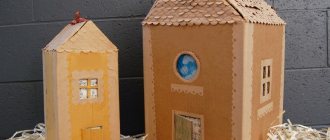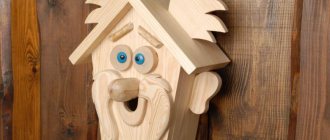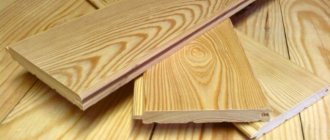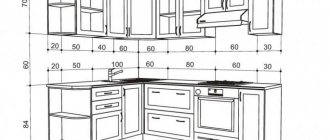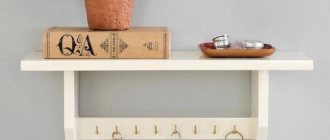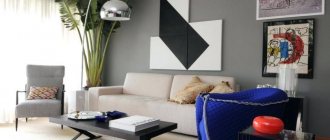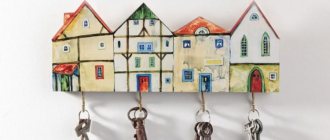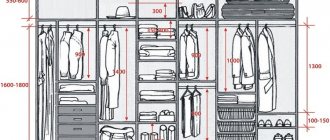A banquette can be called a popular type of furniture for the hallway. Over time, its design has not undergone fundamental changes. This is not only a comfortable pouf on which you can seat guests, but also a stylish piece of furniture; it will look great in the hallway, kitchen, bedroom and living room.
The stores have a huge selection of these soft poufs: with cabinets, shelves, drawers. Each manufacturer designs the banquette at its own discretion. But what to do if you still haven’t found a suitable option for your interior? In this case, the question may arise: how to make a banquette with your own hands?
The basic design of a banquette is quite simple - a stool with a soft seat.
The fabric is folded inward at the edges and secured with staples.
Making a banquette yourself
Making a banquette for the hallway with your own hands consists of several steps. Each of the stages is quite simple, but they all require care and accuracy.
Required materials and tools
Banquettes with wrought iron frames and forging will require certain skills and professionalism. In this article we will look at the possibility of making a wooden bench with your own hands.
Necessary materials:
- Wooden beams measuring 30 by 40 or 30 by 50 mm;
- The legs can be taken from an old stool or coffee table;
- Glue, screws, pins and furniture corners;
- Plywood or MDF sheets.
The upholstery consists of a cover and a filler. The filler is usually foam rubber. It holds its shape well. If you want to make the seat softer, you can take padding polyester.
For manufacturing you will also need the following tools:
- drill, jigsaw and screwdriver;
- hammer;
- screwdrivers;
- needles and threads;
- construction stapler;
- level;
- sandpaper;
- paint, varnish and stain (optional).
Preparatory stage
Before you start making a bench, you should make a drawing. It is necessary to accurately determine the size of the room and the future product.
First you need to decide on the model. A bench with a back will be difficult to implement if you lack experience, so it is better to choose a simple, wooden model without a back. Next, based on the selected model, you need to calculate the dimensions of the remaining parts.
Advice ! If you are planning a lot of parts, then you should make a pattern, and only then start cutting the plywood.
The parts need to be cut out with a jigsaw and their edges treated with sandpaper.
Product assembly
You shouldn’t make all the necessary parts in one day, especially if this is your first experience making furniture. It may happen that you make a lot of mistakes and something will have to be redone.
First of all, you should make a seat and start from its size. Other parts are much easier to fit to the seat.
Then you need to make the legs. As mentioned above, you can take ready-made ones, but if you want to make new ones, especially for the bench, then you need to take the beams, process them using a hand cutter, and attach them to the seat with self-tapping screws. The workpiece must be coated with stain or paint.
Attention ! A hand cutter will make the legs more stylish and neat. This tool is simpler and cheaper than a milling machine
It will allow you to make the legs round or with non-standard protrusions.
If the future product will rest on the sidewalls, then in this case all the parts are prepared at once, cut out, polished, and then simply assembled together. You need to assemble it onto pins; for them, special holes are made at the ends of the workpieces.
After the work has been done, you can begin upholstery. The first day you need to cut out a piece of foam rubber of the required size. And then secure the foam rubber with glue and a construction stapler to the base. It is advisable to place burlap or any coarse material under the foam rubber.
Then from the selected fabric you need to cut out a piece of the required size with an allowance. After cutting, the fabric must be carefully tucked and secured with a construction stapler.
Creating a Bench
Remove the seats and front legs from both chairs using a screwdriver or screwdriver. To create a bench, you only need the backs, front and back legs of the chairs. If you don't want the material to go to waste, carefully disassemble it into pieces. You can use the remaining material for additional parts of the bench.
Now, using the chair legs and other parts, you should take them apart into parts, gluing them together to form a rectangle. In a word, make a rectangular frame connected to each other with screws and nails - at your discretion. We recommend using a drill for better assembly.
Next, if desired, take a saw and cut some more wood, and then add some material to the sides of the future bench to strengthen the side walls. This will allow the bench to be stable.
A student at the Vietnam Police Academy shared how she takes care of her facial skin.
Lost weight: what Sofia Tarasova sacrificed for the sake of “VIA Gra” (new photos)
Smooth and fresh skin: dermaplaning, or why a woman needs to shave her face
We cover furniture with fabric ourselves
The method described above allows you to ultimately obtain a product with an absolutely flat surface. But while this option looks quite presentable on two- or three-seat versions, a single-seat banquette will have a completely boring appearance. A pouf that has a carriage tie looks much more interesting.
To do this, take:
- the same tools, including a hand cutter;
- softer and thinner fabric, because it will need to be folded;
- large buttons that are covered with exactly the same material.
Manufacturing process:
If you have some skills, you can mark the places where the buttons are attached directly on the foam rubber. But it is much more preferable to make a pattern: a sheet of paper of the appropriate size, on which you can calculate the number of fastenings and the shape of the folds.
- Lay the padding polyester and use a hand cutter to cut out the holes for the buttons.
- After this, place the fabric on the seat. It should be laid evenly, but without tension, because folds will form during fastening.
- Afterwards, sew buttons to the fabric in the previously marked places.
- Attach strong strong threads or cords to the buttons, pull them through the holes with a crochet hook and secure them with a stapler.
- Straighten the folds; you can steam the fabric if it became somewhat wrinkled during upholstery.
Types of decorative coatings and finishing of the facades of built-in wardrobes for the living room
Decorating will allow you to make the facade the most advantageous element of the room. The main types of finishes are:
- Mirror. In modern models, all mirrors are covered with shockproof film. This will save you from splinters and the risk of injury. In addition, such a mirror can withstand a heavier load. Visually enlarges the space due to reflection. Another decorative technique is partial tinting or applying a matte pattern;
- Perforated panels. They are of an overhead nature, so the openwork strips are attached to the base of the facade. Very beautiful, but accumulate dust inside the cavities of the pattern;
- Veneer. It consists of very thin sheets of wood or natural stone. They are used to cover the facades. This is also a very expensive way to decorate the interior. It is afraid of moisture and may warp because of it. Requires special care;
- Faux leather. It is made with a complete imitation of natural material and has a soft, pleasant-to-touch surface. The coating is durable, does not fade, and is easy to clean.
The leader in terms of decor is glass. Modern industry has learned to do a lot with it:
- Float glass Durable, smooth and shiny. Defects are not allowed;
- Optiwhite. This is the name given to clarified glass, in which the ability to transmit light is maximized. A wonderful option for films, enamel and color printing;
- Colored;
- Tinted;
- Lakomat. The entire surface is covered with a layer of matte varnish. The more it is, the lower the transparency;
- Matelux. Plain or tinted glass is etched with acids until partial or complete loss of transparency;
- Lakobel. The reverse side is painted in any desired color;
- Matelak. On one side the glass is painted, and on the other it is etched with acid until matte;
- Acrylic glass. Essentially, it is transparent glossy plastic that transmits light no worse than glass. Very durable, will last a long time. It comes with a mirror coating (plexiglass).
Making a banquette yourself
Making a banquette for the hallway with your own hands consists of several steps. Each of the stages is quite simple, but they all require care and accuracy.
Required materials and tools
Banquettes with wrought iron frames and forging will require certain skills and professionalism. In this article we will look at the possibility of making a wooden bench with your own hands.
Necessary materials:
- Wooden beams measuring 30 by 40 or 30 by 50 mm;
- The legs can be taken from an old stool or coffee table;
- Glue, screws, pins and furniture corners;
- Plywood or MDF sheets.
The upholstery consists of a cover and a filler. The filler is usually foam rubber. It holds its shape well. If you want to make the seat softer, you can take padding polyester.
For manufacturing you will also need the following tools:
- drill, jigsaw and screwdriver;
- hammer;
- screwdrivers;
- needles and threads;
- construction stapler;
- level;
- sandpaper;
- paint, varnish and stain (optional).
Preparatory stage
Before you start making a bench, you should make a drawing. It is necessary to accurately determine the size of the room and the future product.
First you need to decide on the model. A bench with a back will be difficult to implement if you lack experience, so it is better to choose a simple, wooden model without a back. Next, based on the selected model, you need to calculate the dimensions of the remaining parts.
Advice! If you are planning a lot of parts, then you should make a pattern, and only then start cutting the plywood.
The parts need to be cut out with a jigsaw and their edges treated with sandpaper.
Product assembly
You shouldn’t make all the necessary parts in one day, especially if this is your first experience making furniture. It may happen that you make a lot of mistakes and something will have to be redone.
First of all, you should make a seat and start from its size. Other parts are much easier to fit to the seat.
Then you need to make the legs. As mentioned above, you can take ready-made ones, but if you want to make new ones, especially for the bench, then you need to take the beams, process them using a hand cutter, and attach them to the seat with self-tapping screws. The workpiece must be coated with stain or paint.
Attention! A hand cutter will make the legs more stylish and neat. This tool is simpler and cheaper than a milling machine
It will allow you to make the legs round or with non-standard protrusions.
If the future product will rest on the sidewalls, then in this case all the parts are prepared at once, cut out, polished, and then simply assembled together. You need to assemble it onto pins; for them, special holes are made at the ends of the workpieces.
After the work has been done, you can begin upholstery. The first day you need to cut out a piece of foam rubber of the required size. And then secure the foam rubber with glue and a construction stapler to the base. It is advisable to place burlap or any coarse material under the foam rubber.
Then from the selected fabric you need to cut out a piece of the required size with an allowance. After cutting, the fabric must be carefully tucked and secured with a construction stapler.
Build process
The procedure is performed in stages. The following steps should be followed:
- First, a seat of the required dimensions is made. The remaining parts will be adjusted to size.
- To make the legs, you need to install the strips, leaving small indentations along the edges.
- The legs are made from solid timber. Using tools, you can give the part any shape you want.
- Next, all the elements are assembled. To make the seat soft, you need to lay foam rubber. Burlap is pre-laid on the bottom to make the structure more durable.
- A piece of the required size is cut out of the fabric. It is secured with glue or a stapler.
The assembly process consists of several stages.
After this, you can begin creating decorations for the finished design. You should decide on the design in advance.
Wardrobe in the hallway from a chest of drawers
The idea is perfect for those who have old chests of drawers or cabinets. You'll need to take apart your old furniture and plan which pieces can be used for the bottom drawer, bench, and sides. If you don't have enough materials or the dimensions aren't right, you can always buy some 2x4s or medium-density fiberboard. And it’s clear that in order to make a wardrobe in the hallway, you must have some skills, you need to approach the matter creatively, you will not be able to follow these instructions exactly and during the course of the project you will have to make some changes based on the materials that you have . The first step to any project is to have a clear picture of the end result. Although, this is easier said than done. For most of us, as we get older, our ability to use our imagination diminishes significantly. We often overcomplicate things, worry about potential outcomes, and allow logic to block creative thoughts. Just try to become a child for a short time and let your imagination run wild. However, in this case, just look at the step-by-step photos and do something similar with your old chest of drawers.
Step. tight fitting
Start pinning the fabric (or mat) to the edge of the plywood. It's best to take your time, plan out the angles and make sure the fabric fits on the seat just the way you like it. I decided to sew the two long sides first. The wrap looks like wrapping a gift. I found it was much easier to hold the mat in place and pin it together with extra hands (thanks to my wife).
Once you have the first two sides sewn together, it's time to fold the end edges over and sew them together as well. If you need to cut part of the rug to fit the size of your bench, you can use a little glue to keep the ends from unraveling and fraying.
Necessary materials
Their list depends on the condition of the banquette. If there are cracks, dents and chips on its wooden parts, you need to purchase wood putty and special wax.
If all parts of the bench are intact, but the varnish on them is cracked, and the fabric of the soft seat has faded, you will need the following materials:
- sandpaper of various fractions (fine, medium and coarse);
- paint or stain;
- varnish;
- a piece of fabric;
- foam rubber for furniture;
- a small piece of felt;
- wood glue;
- cant.
Note to weather dependent: the magnetic storm forecast for March promises six strikes
Italian dinner for 250 rubles: the simplest pasta recipe from 3 ingredients
Gusev said that the scammers managed to fraudulently take possession of his mother-in-law’s apartment
The edging is a thin ribbon sewn along the contour of the bench. You need to measure the perimeter of the seat and add 4-5 cm to the result (just in case). This way you will know what length of piping you will need.
Also, for work you need to have threads on hand to carefully sew the ends of the edging. You may need screws or screws if the old ones cannot be reused.
Illuminated mirror for dressing table
Here's a step-by-step guide on how to make a lighted vanity mirror. You just need to make a wooden frame. Sand well and apply stain. Once dry, apply a couple coats of water-based semi-gloss polyurethane using a high-quality brush. Leave to dry overnight before installing LED lights. Place the light bulbs on the frame, taking into account the distance between them. Then I just peel off the backing and glue it on.
If the wires start to sag a little, stretch them and glue them to the back of the frame to make them less noticeable.
Photo source: jenwoodhouse.com/diy-makeup-vanity-mirror-with-lights/
Dressing table with drawers
For something stylish and functional, check out this stenciled makeup vanity with a gold table base inspired by contemporary art star Oliver Gal. You can use the step-by-step photos to recreate this unique vanity with your own hands. If you're a little intimidated by how difficult it is to assemble, don't worry, there are very detailed step-by-step instructions on the website. But check out this stencil painting first. The author of the project is very proud of how he implemented this design. There are many vanity table designs available online, but none of them look quite like this one. In the article you will learn all the secrets about how this design was created, so use the link to find out all the details.
Photo source: handmade-haven.com/blogs/news/diy-vanity-desk
Step-by-step manufacturing instructions
Scheme and drawing for the hallway
Before you start making a bench, you need to think about its design, dimensions and materials.
Take into account the size and design of the hallway in which the furniture will be located. After this, a drawing of the future piece of furniture is created
You can do it in different ways:
- by hand using a pencil and a piece of paper;
- using special computer programs;
- using a ready-made drawing found on the Internet.
Each individual option has its own advantages.
Help: when calculating the dimensions of the bench, it is worth starting from the fact that for one user you need an area measuring 45 by 55 cm.
Tools and materials
The easiest way is to make a banquette with your own hands from wood and textiles. Foam rubber is used as a filler.
Materials you will need:
- a wooden beam for making legs measuring 30 by 40 cm or 30 by 50 cm (instead, you can use restored old legs from a table or stool);
- plywood;
- fastening systems;
- paints and varnishes;
- stain;
- antiseptics;
- foam;
- upholstery fabric;
- buttons;
- fabric scrap for the invisible side of the product.
The tools you will need to prepare are:
- drill and screwdriver;
- screwdrivers;
- hammer;
- stapler;
- sandpaper;
- level;
- scissors;
- roulette;
- pencil;
- chalk and a sewing machine (for making a cover).
How to do it at home?
The process of making a bench with your own hands is as follows:
- First, the legs are made from timber. They will be attached to the frame of the product with screws and corners. If possible, it is better to process the timber with a hand router. Then it will be possible to make original protrusions and the products will turn out to be more exclusive. It is recommended to paint the timber with stain or paint.
- If you have finished legs from an old table, they need to be restored. To do this, the surface of the products is cleaned with sandpaper and painted with stain or paints and varnishes.
- Now we take plywood of the required size and shape and cut out foam rubber along its contour. It should be a few centimeters larger.
- The foam rubber is glued to the plywood with glue, and, armed with a tape measure and chalk, we begin marking the lines where the decorative buttons will be located.
- Next, we cut out the upholstery (leather, cotton, linen) according to the shape of the seat. In this case, it is necessary to reserve several centimeters of fabric on each side. Carefully attach the fabric to the seat and shoot it with a furniture stapler.
- Now we move on to decorating the product with buttons.
Tip: you can cover the rough finish on the back of the product using textiles. A piece of fabric cut to size is simply sewn along the edge to the bottom of the bench.
We have looked at the simplest option for making a bench, which even a beginner in carpentry can handle. This model is distinguished by quick assembly times, aesthetic appearance, and ease of use.
Master class on decorating
As for the finishing, it all depends on the materials used to make the bench. Metal frames are treated with anti-corrosion compounds, protected and covered with varnish or paint. Wooden products are also treated with antiseptics, and then covered with varnish or paint in several layers.
As for the upholstery of the product, the color of the textiles must be chosen according to the overall interior of the room. When using buttons as decoration, they are matched to the color of the upholstery material. Their number depends on personal preference.
To make the bench more practical, it can be upgraded with a removable cover. This will make it much more convenient for you to maintain a clean and tidy appearance of the furniture item.
Important: for luxurious classic Empire or Rococo styles, the upholstery of the banquette can be done using the carriage screed technique. This decoration option looks presentable and noble.
Tip: you can also make a wardrobe or wardrobe in the hallway. And next to the banquette a small coffee table will look great.
Tags
with your own hands banquettes with your own hands with your own hands banquettes with your own hands. with your own hands no. with your own hands you won’t be able to do it Advantages of making your own How to make a banquette in the hallway made by your own Advantages of making a banquette with your own How to make a banquette How to make a banquette The point of making a cutter will make the legs to make it Assembling a banquette with your own Banquette with your own hands a banquette to make a banquette for with your hands banquettes We make the banquette your own.
ottoman
Materials
The soft seat is filled with foam rubber. To do this, cut a suitable piece from a large piece of material. To make a bench, it is enough to become familiar with the types of existing upholstery used for such work.
The fabric that will cover the pouf can be made of linen or cotton. Textile models are quite easy to care for. This upholstery is often chosen due to the large selection of material shades.
Other materials for cladding:
- Leather. This material is quite expensive, and may not suit every interior style. However, such a pouf will look quite aesthetically pleasing. The disadvantages of this material include the high price and the need for careful care.
- Faux leather. This option is similar to the previous one, but costs much less. The material looks as elegant as genuine leather. However, such a banquette will not last so long.
Forged products or poufs with a steel frame should be made only with full confidence in your skills in working with metal. The easiest way to make a banquette is from wood. The pouf is usually filled with foam rubber. This material is durable and practical. It is able to hold its shape for a long time and is quite elastic. To make the legs of the pouf more attractive, you should decorate them with hand carvings.
To construct a banquette for the hallway, you will need to prepare the following materials:
- For a pouf that will have legs, you should find wooden beams of different sections - 30x40 and 30x50 mm. You can find and use old legs that used to support a stool.
- Plywood sheets.
- Various fasteners - staples, screws.
- Paint or stain.
- Thick foam.
- The fabric with which the bench will be covered.
If desired, you can sew a cover to cover the pouf. This will make caring for it much easier. The fabric for the pouf should look organically with the textiles of the hallway. When constructing a soft seat, in addition to foam rubber, you should use padding polyester. If you are creating a bench with legs, you need to attach 4 wooden planks to its bottom so that they protrude 2 cm beyond the edges of the product.
Required Tools
To work you need to have the following tools:
- drill, screwdriver;
- screwdrivers;
- hammer;
- construction stapler;
- sandpaper of different hardness;
- hand cutter (if the base of the pouf is made of timber);
- level;
- thick threads and a large needle;
- scissors;
- roulette;
- chalk;
- sewing machine (if you need to sew a cover).
In addition, paint or stain and varnish may be needed.
The seat is cut out first - its dimensions serve as a starting point, and all other parts, if necessary, are adjusted to fit the seat.
If you do not have sufficient experience in making furniture, then it is better to split the whole process into several days so that every detail is given due attention.
Step 1: Finishing the Legs
If you have ready-made screw-in legs, then they need to be restored. Clean the surface with sandpaper. Then we apply new paint or varnish and stain. It is better to apply in two layers.
If you don’t have ready-made legs, then they need to be made from timber. They will be attached to the seat using screws and corners. If possible, it is better to process the timber using a hand cutter. Such a tool can make non-standard protrusions, and the product will turn out more interesting. We also cover the timber with stain or paint it.
Step 2: Plywood and foam
It is necessary to cut the foam rubber of the required size around the plywood. In this case, it should protrude 2-3 cm on each side. We select sizes individually.
Step 3: Mark the plywood
We glue the foam rubber to the plywood, placing the glue closer to the edges. Using a tape measure and chalk, we will draw markings along which we will later sew on buttons. We make several holes in the plywood at the same distance. We try not to touch the foam rubber.
Step 4: Assemble the product, cover it with fabric or leather
We cut out a square or rectangle from leather or fabric according to the shape of the product. It is necessary to carefully calculate the dimensions of the upholstery and fit them under the seat, leaving a margin of 2-3 cm on each side.
Next, you need to carefully wrap the fabric and secure it with a stapler.
You can start installing buttons. Using a needle, thread the thread first through the button and then out into the hole in the plywood under the seat. For better fixation, you can secure the thread with staples.
You need to cover the rough trim on the back of the seat with a textile cloth. Sew the cut piece along the edge of the bottom part.
If the legs were from another product, then choose a place to place them, fasten their bases with self-tapping screws and screw them in. We attach the timber legs to the seat using self-tapping screws and corners.
The process consists of several stages. All of them are quite simple to implement and require only accuracy and due care.
It is not recommended to make all the necessary parts at once, especially if this is your first experience in furniture production.
What shape can a banquette with a seat have in a hallway?
The traditional shape of a banquette for a hallway is considered rectangular. This design can be installed along the wall anywhere in the room. It has a hard or soft seat with upholstery, there are models with and without a backrest. The last option is often used for small corridors. A narrow banquette in the hallway can also serve as an element zoning the space.
Traditionally, hallway banquettes are rectangular in shape.
Corner banquettes are distinguished by a stylish design and the presence of a spacious drawer, which is located under the seat and acts as a lid. It is convenient to store not only shoes, but also other useful items. Such models are mainly made to order.
Banquettes with a storage box that have a round shape will look aristocratic and beautiful. In appearance, the products resemble small poufs. The structure is fully equipped with soft upholstery. Under the top cover, which acts as a seat, there is a storage compartment. It is not recommended to place shoes here, since there are no specially designated shelves.
Most often, banquettes for hallways do not have a back
Decorations
To update old furniture and make a banquette out of it, you don’t have to spend a lot of time and effort. The main thing in such a product is softness and the availability of storage space (drawers, shelves). When the transformation of old furniture is already completed, it's time to think about decorations. When translating your ideas and fantasies into reality, you should not limit yourself. After all, the finished banquette should please the eye, and not stand sadly aside
Therefore, it is important to design it so that it simultaneously catches the eyes of guests and harmonizes with the interior
A product made in a classic style is suitable for the hallway.
This is especially important if you also need a shoe rack. The purpose of the bench in this case is more for storing shoes than for a comfortable stay on them
At the same time, it should be noticeable and covered in leather or leatherette. In a children's room, such a product can have any style. The main thing is that he takes into account the situation. For a girl, the banquette can be decorated with velvet and voluminous flowers. It will be very interesting if the cover is knitted by mom. For a boy, a product in the shape of a soccer ball will be original. It will be even more interesting if there is space inside to store toys.
Often banquettes are made specifically for weddings. Guests can sit on them very easily and simply. All banquettes and poufs at this event must be made in the same style. So they look very nice against the background of the hall. Satin ribbons or embroidered patterns will look very gentle on them. Of course, this is painstaking work, but such products look impressive.
Making a soft bench or ottoman with your own hands is not very difficult, but it requires care and precision.
It is important to correctly assess your strengths and use a drawing that is suitable for a novice master. And we must not forget about the versatility of the product.
They not only sit on the bench, but also store small items in it.
The next video is a master class on making banquettes.
What to make an ottoman from
The easiest way to make an ottoman yourself is from scrap materials or old furniture.
A soft seat crocheted in the shape of a tablet or a round pillow - for children and teenagers who like to play on the rug.
A frame and stable legs taken from chairs or stools, as in the example of a do-it-yourself ottoman in the photo, are a reliable product for adults.
7, 10 or 16 plastic bottles wrapped with tape are an excellent option for using household rubbish. All that remains is to think about the upholstery on top of the foam padding, perhaps with a patterned cover with a zipper.
It is recommended to use old fabric stocks as textile upholstery:
- Unnecessary curtains and baby blankets;
- Pieces of natural or artificial fur;
- Leather, suede, raincoat fabric from obsolete outerwear.
If you want to update other furniture, it is recommended to choose inexpensive but effective upholstery fabric. The common upholstery material will add chic, stylistic unity and a sense of completeness for different interior items.
Experts recommend:
- Velours;
- Jacquard;
- Flock;
- Eco leather;
- Tapestry;
- matting;
- Rep corduroy;
- Chenille (chinille).
Shared upholstery fabric is useful not only for the ottoman. You can sew sofa cushions from it. General covers to renew chair-beds, soft seats of chairs and stools. To this list we’ll add a homemade ottoman made from plastic bottles or a banquette - this is the secret to updating furniture on a budget.
The ottoman can be made in the form of covers for storing quilted blankets that have nowhere to put in the summer. To do this, the product is sewn in the shape of a cylinder with zippers, into which a rolled and neatly tied blanket is placed.
Models and functionality
The main types in which banquettes are presented today are divided into many different models, differing from each other in various parameters (purpose, material, presence of additional elements, size).
Banquettes with shelves effectively solve two problems at once: they provide comfortable seating for 1-2 people and allow you to neatly and compactly place indoor or outdoor shoes, household and household items. Such benches most often have a rectangular shape, and in their lower part there are 1 or 2
Banquettes with a back are the most convenient and comfortable option. You can not only sit here for a short time, but also sit down for a telephone conversation or read a book, for example. The model is often complemented by one or two armrests. Soft materials are used as upholstery.
A bench with a drawer is usually designed to store shoes, but it can also serve as a place for other items. The model is equipped with 1-2-3 drawers, which can be of different sizes, for example, for storing large items and small items.
The model with a bedside table is an original piece of furniture, which is most often decorated in an antique style. Curved legs, a compact bedside table for a phone, a book, keys, a beautifully designed seat, a backrest, a comfortable armrest - this banquette resembles palace furniture. First of all, it will play the role of an original interior decoration and only then a functional item.
A banquette with a table is a variation of the previous option, only the bedside table here also plays the role of a small table where you can leave anything you want - from keys and a cell phone to the morning newspaper and a cup of coffee.
As for the design differences, they mainly consist in the shape, design and size of the legs, seat and back.
Banquettes can have a rectangular, square, round or oval seat, which, in turn, can be soft, hard or semi-hard. The soft model can easily replace a small sofa, and the hard one is a beautiful alternative to a regular bench.
Banquettes can have legs of different thicknesses, shapes and sizes or be made without them (poufs). The abundance of modern models allows you to choose the appropriate height option (for a child, a tall person, the elderly). The legs can have a variety of shapes: straight, curved, crossed. Furniture with legs is multifunctional. Usually it plays the role of a bench, sofa, ottoman.
Models with a backrest can be supplemented with one or two armrests and have a base of different rigidity. Such options are more suitable for spacious rooms, as they take up quite a lot of space.
Ordinary metal or wooden benches look more elegant and compact. They do not have a back or armrests. They are mainly used to sit down for a few seconds while putting on shoes or putting the finishing touches on an outfit.
Decorating a banquette
Buttons should be selected in accordance with the shade of the upholstery of the bench seat. Their number depends on personal desires. The bench can be diversified with a decorative cover. It is usually performed in the same style as the upholstery. This kind of work is not difficult. You just need to know how to operate a sewing machine.
If you do not have cutting skills, you should choose a ready-made pattern. You can learn how to create it using certain master classes. Calculate in advance what capacity the banquette will have. For one person an area of 45x50 cm is required.
Elements of the bench are cut out using a jigsaw. Their edges should be sanded. When installing a pouf in an Empire style hallway, a carriage screed can be made. Such products look presentable and original.
It is important to determine the size of the hallway and the dimensions of the banquette to be made. In the case of a large number of parts, you should first make a pattern, and then start cutting the plywood
How to wear and care
Caring for bandalettes is no different from caring for any other synthetic or natural item (in the case of cotton). The only thing to keep the product as long as possible is to try to hand wash it. It is worth pointing out that for washing you need to use only laundry soap or those compositions that are made on a natural basis. The use of aggressive compounds will lead to rapid wear and damage to the aesthetic appearance of the finished product.
As for the moment of drying, it is better to do it on a dryer, without a heating device or battery. This way it’s better to preserve the elastic and you won’t have to alter or throw away the item after several months. No ironing required.
Hand wash as basic care
As for how to wear the products, the bandages should be located on the hips at the very top. You need to wear them right down to your underpants to cover problem areas. If models are created with a protruding seam, then it does not turn inward, but goes outward.
Note! There is no need to allow the laundry to fall down. This is the only way to ensure maximum durability of the model.
Proper wearing is the key to safety
In general, bandages are elastic, soft bands whose main purpose is to prevent chafing on the inner thighs. At the moment there are different styles. They are created using regular elastic and silicone. You can sew them yourself using the available step-by-step instructions, master classes and patterns. You can wear them like regular underwear, namely stockings. Caring for them is simple: just wash them periodically with your hands using laundry soap.
Decorating a banquette
Buttons should be selected in accordance with the shade of the upholstery of the bench seat. Their number depends on personal desires. The bench can be diversified with a decorative cover. It is usually performed in the same style as the upholstery. This kind of work is not difficult. You just need to know how to operate a sewing machine.
If you do not have cutting skills, you should choose a ready-made pattern. You can learn how to create it using certain master classes. Calculate in advance what capacity the banquette will have. For one person an area of 45x50 cm is required.
Elements of the bench are cut out using a jigsaw. Their edges should be sanded. When installing a pouf in an Empire style hallway, a carriage screed can be made. Such products look presentable and original.
It is important to determine the size of the hallway and the dimensions of the banquette to be made. In the case of a large number of parts, you should first make a pattern, and then start cutting the plywood
Unusual ideas
Talented craftsmen have long been using old products that have either become unusable or simply lost their relevance to create new pieces of furniture. Therefore, it is not at all necessary to create a product from scratch; you can restore an unnecessary coffee table or stool. The main thing is that you have enough imagination for it. An interesting option for creating a banquette is to use an old wooden box. To do this, you need to remove the locks and hinges from the box. If there are any irregularities, they need to be sanded. The box itself can be painted in a bright color, and the lid can be covered with leather (previously with foam rubber). The inside of the box also needs to be tidied up: sanded and painted.
A banquette made from old chairs will look original. To do this, take two chair backs with rear legs and connect them using two bars. The bars need to be secured with corners and self-tapping screws. Then a seat is made from plywood and covered with foam rubber and fabric. A bench made of plastic bottles is this year’s trend. To make such a product, you will need to prepare approximately 40 bottles, cardboard, tape, glue and foam rubber. The bottles are fastened to each other with tape, and then glued to the cut cardboard on both sides: on the bottom and top. After this, the structure is covered with foam rubber and covered with fabric. An old shoe rack can become a multifunctional product. To do this, it needs to be sanded and painted. Then at the top you need to make a seat from a synthetic padding pillow, which is first placed in a cover and attached to the shelf.
Why do you need a banquette?
A banquette is a kind of stool, or a small bench with a soft seat, usually without a back. Sometimes you don’t even think about it, calling it by all its boring names – chair, chair. And its purpose, like all furniture of this kind, is to sit on it. In the kitchen this question is more relevant than in other rooms. It's always nice to sit on a soft chair and drink a cup of coffee.
Beautiful carved bench for the kitchen
There are also banquettes with a drawer for the kitchen. The entire lower part of the stool is covered with plywood and thick fabric, forming a small box. This simple solution can be used to store small household appliances or other kitchen utensils.
Choosing a piano chair
join the discussion
Share with your friends
Excellent piano playing requires skill and talent. But incorrect posture and uncomfortable sagging of the arms will hinder even an experienced musician. A special chair, the height of which can be adjusted for each performer, helps you take the necessary pose. We’ll tell you about the types of chairs musicians have and which one is better to choose in our article.
Preparation
At the preparatory stage, a drawing or sketch of the future product is created, where all the optimal dimensions are indicated. When planning the length and width, keep in mind that a seat for one person is calculated as 45x55 cm. And also:
- You need to think through the design in advance: a regular pouf, a bench with a back, the presence of legs, shelves, drawers/non-drawers, etc.;
First, let's come up with a design for a banquette. - Based on how many seats the banquette is designed for, determine the dimensions of other elements, transfer ideas and measurements to a sheet of paper;
Let's transfer our idea onto a piece of paper. - If there are a lot of parts planned for the frame, and it consists of a back, a partition, a shelf, it makes sense to make a pattern and cut the plywood;
- A jigsaw is used to cut out parts.
Consider the availability of space for drawers or opening bedside doors, if these are included in the project.
Product assembly
Experts do not recommend cutting out all wooden parts at once. During the assembly process, deviations may appear, for example, the shelf will be too small for the opening or, conversely, will be larger than necessary.
The manufacturing process includes the following steps:
- The seat is cut out first - it will serve as the starting point to which all other components are adjusted.
Banquette base. - If you are planning a model with legs, 4 slats should be attached to the bottom so that they extend 1-2 cm beyond the edge. The main fasteners in this case are screws and furniture corners. Using a cutter will give the legs a more extravagant and attractive appearance. Rounding, making smooth, cutting off protrusions and much more with such a device becomes a simple task.
- The resulting workpiece is carefully processed with sandpaper and a layer of varnish or other decorative coating is applied.
We process the workpiece. - In the case where the product rests on solid sidewalls, all spare parts are cut out at once. The resulting shelves, seat, bottom and sides are sanded and attached to pins, which are placed in pre-drilled holes.
- Before assembling the structure, all components are coated with a layer of varnish.
We cover the structure with a layer of varnish. - When the design is ready, you can begin to cut out a suitable piece of foam rubber, which is attached to the base of the bench with a stapler or glued with glue.
It is recommended to place burlap or similar rough material before the soft layer. Let's start cutting out the soft base. - Next is textile design. It is necessary to cut the fabric of a given size, but with an allowance so that it is possible to tuck it a little and secure it with staples.
Do-it-yourself furniture upholstery
The technology described above allows you to design an ottoman with a perfectly flat surface. And if a long and wide one will look strict and neat, then a small one will look bland and cheap. Think about a carriage screed - this is one of the easiest and most cost-effective options to decorate a “dull” surface.
To create such a covering, you will need all the same materials and tools as when constructing a bench, with the difference that it is better to take thin fabric so that it is convenient to form folds from it, and you will also need buttons covered with the same material.
- The soft part of the bench usually consists of foam rubber and a layer of synthetic padding laid on it, although the latter is often not used, then the surface remains a little harder.
Banquette with soft seat. - The locations of the buttons can be marked directly on the porous material, but for a beginner it is recommended to make a layout of the pattern on paper, on a scale of 1 to 1, where the locations of the buttons will be outlined in detail and the shape of the folds will be thought out.
One of the simplest and easiest options to implement is diamonds, but if desired, more complex patterns can be implemented. Banquette with buttons. - Holes are drilled through the marks.
Drill a hole according to the marks - Next, lay the padding polyester, first leaving openings for the buttons.
- Then a layer of material is placed on which the accessories are sewn, in the designated places, relative to the sketch or workpiece.
- At the end, the folds are straightened and treated with steam if they have become wrinkled during the work.
This product looks very original, and making it with your own hands is not difficult.
DIY banquette
Stages of work
- Our banquette in the hallway will have the shape of a small open sofa, the dimensions of which each master must determine independently, based on his needs and the location of the furniture, so at the first stage it is necessary to complete an assembly drawing of the product with its detailing.
- The bench consists of a set of cubes having 2 side walls, a bottom, a lid and a back wall (the front wall remains open to provide access to the interior space).
- To ensure accuracy of subsequent installation, we carefully ensure that the dimensions are observed according to the drawing. It should be noted that the top covers are attached to the top of the side walls, and the bottom and back panel are located inside the product, and the side panels should protrude 5-7 mm beyond the bottom surface to create legs. This should definitely be taken into account when marking.
- We mark the furniture panel according to the drawing and, using a jigsaw or hacksaw, cut out the corresponding parts in the required quantity. For a bench consisting of 3 cubes, there should be 15 such parts: 6 side walls, 3 bottoms, 3 lids and 3 back panels.
- We process the resulting parts with sandpaper to smooth out sawing defects and remove irregularities.
- After this, we connect the manufactured parts using furniture pins. To carry out this process, strictly according to the markings, we drill blind holes in the ends of the corresponding parts, and counter holes - on the plane of the paired elements. The diameter of the holes should match the diameter of the pins, and the depth of the holes should match their length.
- We assemble structures and eliminate identified deficiencies. After eliminating the defects, we mark all the parts and disassemble the product.
- We glue the pieces together sequentially using wood glue. To add additional strength, we screw self-tapping screws into critical points.
- As a result, you should have 3 identical cubes with an open front surface.
- At the next stage, we make a soft place for the seat. This could be, for example, a hand-made mattress. Its dimensions must match the dimensions of the boxes placed in a row.
- Foam rubber is suitable as a soft filler for a mattress. You can choose its thickness at your discretion. The mattress cover is cut out and sewn based on the specified dimensions.
- The resulting boxes must be fastened into one structure. For this purpose, a special furniture metal sheet is used, with which the drawers are connected in pairs along the back wall using screws.
- Products can be decorated with a variety of paints and varnishes intended for working on wood.
- After complete drying, we place the mattress on top of the structure, and our banquette for the hallway is ready for use.
If desired, the cavities of the product can be equipped with special drawers made of lighter material.
If you are still thinking about the question “how to make a banquette yourself,” by following the instructions above, you can achieve your goal with minimal investment of money and time. By completing this work, you will not only gain invaluable experience, but also decorate your hallway with an original and very useful accessory, which is also made by yourself, which is even more valuable.
Master class No. 1: making a banquette from a coffee table
Materials:
- Old coffee table;
- Foam 2 inches high;
- Cotton wool (the thicker the better);
- Stapler;
- ½-inch wide plywood cut to size;
- Aerosol glue;
- Textile;
- Grinding machine;
- Primer;
- Dye.
For the most upholstered coffee table, wrap foam/wadding/fabric around the top of the table and sew the fabric to the bottom. See picture below:
I took this table and made this banquette out of it:
I wanted to maintain the rounded, curly edges and details of my coffee table, so I decided to make the banquette a little differently. I first took ½ inch wide plywood and then attached it to my coffee table.
Cut your sheet of plywood a little smaller.
Cut out your foam; I recommend that you use foam that is ¾” longer and wider than your sheet of plywood.
Use a serrated knife to cut the foam (I used a bread knife and it worked great). I used 2 pieces of foam.
Cut your cotton wool. You need the wadding to be 2 inches longer and wider than the foam (Cut the foam and wadding larger than your countertop because when you upholster the plywood, they will wrap around the edges, making them rounder and softer). Cut your fabric. It should be a few inches longer and wider so that it can wrap around all of the above in a circle, both the back of the table and the front that will be trimmed. You can see in the picture how the layers are arranged. From bottom to top: table, plywood, foam rubber, cotton wool, fabric.
Attach your pieces: Use spray adhesive between each layer (plywood and foam, foam and wadding) so that the layers do not move.
Fabric and staples: Cover the fabric tightly to all layers (plywood, foam, cotton wool) and staple it to the back of the tabletop.
Edge processing instructions:
I'll give part of another lesson. Turn the workpiece over with the back side up. Cover the fabric on all sides as shown in the picture. Use a stapler to attach the fabric to the bottom of the seat. I started stapling along the long side. I then stretched the fabric and secured it with another staple along the other long side (opposite). Secure with several staples on each side, then go back and attach again on each side.
You must pin all four sides together before moving on to the corners. When folding the corners, try to fold them as neatly as shown in the picture below:
Now let's go back to our banquette. Let the soft top just rest to the side - now you need to paint the legs and attach them to the top.
How to finish the bottom:
Sanding is a great idea. I want to remove all the shine from the surface so that the paint will adhere better. I used a 120 grit hand sander. Sand the legs and sides and then prime everything. I used 1-2-3 Bullseye water based primer. Wait until everything is dry. Paint the table, I used ivory spray paint. I needed 3 coats to get good even coverage.
And here is our banquette in the living room, made with our own hands from old furniture:
Installing the bottom shelf
When installing slats, we start by placing pine planks on the sides. The entire further process is shown below in the photographs. Apply wood glue to one side of the pine plank and secure it in place. Then hammer nails into the pine strips to hold them in place while the glue dries. Do this for both sides. Now place the base on the floor or work surface, right side up. Using crosses that can be bought at any hardware store, we fix the planks at a certain distance from one another. Apply glue and nail each plank. We remove the crosses.
Types of banquettes
There are several common types of banquettes. They differ in shape and strength, but each has its own undeniable advantages that deserve attention:
- Forged. Similar products are chosen for installation in hallways in the Empire or Baroque style. The base of such a pouf is forged and twisted. Often such specimens do not have internal shelves or pull-out sections. Products made in this style are best installed in hallways.
- Wooden. These banquettes are distinguished by wide functionality. They often have many built-in drawers and shelves. Such products look great in the kitchen, hallway or guest room. The advantage of the models is that over time they only acquire a special charm.
- Banquettes with backrest. Such models are small sofas. They are very comfortable to sit on. Banquettes with a back should be decorated with small pillows.
- Collapsible. Such designs are quite functional. They are easy to disassemble and transport. Each element is fixed with bolts. Typically, such banquettes have a simple design. This is explained by the need for their quick disassembly.
- With boxes. In the hallway, such a copy will come in very handy. It's a great space saver. You can store seasonal clothes or shoes or care items in the drawers.
These banquettes are the most popular. If you create any of these models yourself, you can add your own original details to the pouf.
Design
In the hallway of a Khrushchev apartment, it is advisable to use minimalist furniture. Avoid excessively small details, try to ensure that all elements of the headset are made uniformly. Closed storage systems are preferable to open ones; they do not create a feeling of space overcrowding and bad taste. Only in the cramped rooms does it make sense to install an open hanger instead of a closet or drawer. Visual softening of corners and maximum smoothness of lines are other important requirements for the design of furniture for the corridor.
With all the beauty of natural stone, relief panels and similar volumetric solutions, refuse them - the absorption of space has too bad an effect on the feeling of it. Important: do not use large patterns, they only spoil the impression. When finishing both furniture and walls, use only high-quality materials and designs that will not lose their attractive appearance for a long time.

